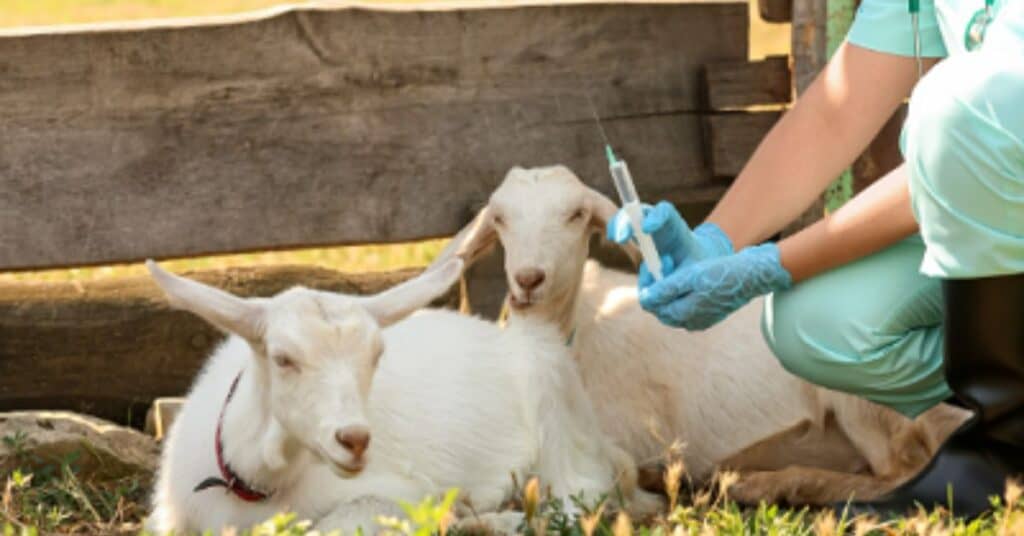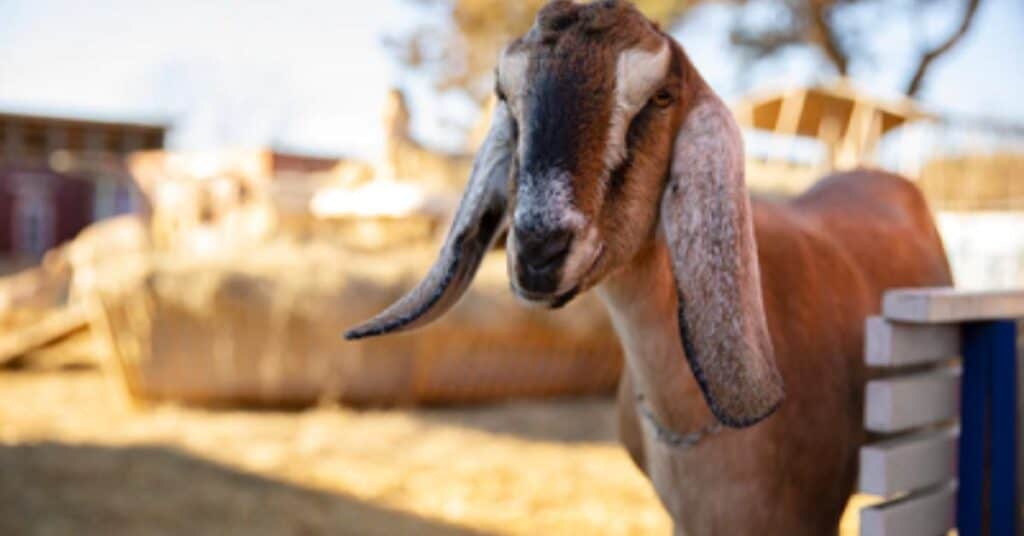A lot of people often as the question, What is goat Polio? They wondered whether it is the same as that of human! Goat polio is a virus-borne disease that affects the nerve system of goats. It is also known as Polioencephalomalacia (PEM). Polioencephalomalacia (PEM) is a frequent metabolic condition characterized by neuromuscular changes in thiamine-deficient goats.
This disease attacks the nervous system and coordination of movements. The main cause of this metabolic disease is deficiency of vitamin B1 (Thiamin). The neurological disorder polioencephalomalacia (PEM) affects the brains of animals, including cattle, sheep, and goats.
We shall be looking at causes, diagnosis, symptoms, prevention and treatment of Goat Polio in this article.
You can also read about Fighting Barber Pole Worms in Goats and Sheep
Let’s get started.
Causes of Goat Polio (Polioencephalomalacia (PEM))
The digestive system of ruminant goats is strongly dependent on rumen microbial conditions. The provision of dry grain feed and excessive concentration ratios in the rumen of goats have a significant impact on rumen microbial activity.
Under situations of excessive consumption of dry pellets and concentrates, rumen bacteria, particularly Bacillus aneurinolyticus and Clostridium sporogenes species, generate thiaminase.
This thiamine has the ability to degrade thiamine and cause a breakdown in carbohydrate catabolism.
This PEM condition is caused by a lack of energy sources and glucose from carbohydrates, which reduces the coordination and neuromuscular systems.
In addition to feeding and concentrates, there are other causes of excessive thiaminese production, such as long-term antiprotozoal amprolium therapy, high doses of antihelmintics, the consumption of sulfur-contaminated feed, and the pattern of grazing feed developed with pasteurized fertilizers.
Polioencephalomalacia (PEM) is a fatal disease for goats. Any alteration to the rumen’s environment that inhibits normal bacterial activity can hinder thiamine synthesis.
Too much grain lowers the rumen’s pH, generating an acidic environment and making the goat susceptible to goat polio.
Glucose cannot be broken down in the absence of thiamine. If thiamine is absent or exists in an altered form (thiaminase), brain cells may die and severe neurological symptoms will manifest.

Photo by Yulia Kishun, Freepik
Other Causes of Polioencephalomalacia (PEM)
Sulfur Toxicity
Sulfur is a trace element that goats require in small levels for normal growth and development. However, high sulfur ingestion can cause toxicity in goats.
Sulfur fights for absorption with thiamine. When sulfur and thiamine compete for absorption, sulfur usually wins. This causes a thiamine deficiency in the goat. Basically, long-term sulfur toxicity can result in thiamine deficiency, which can lead to goat polio.
The chance of goat polio developing increases when the goat’s food contains more than 0.4% sulfur.
Loss of appetite, lethargy, diarrhea, respiratory distress, and liver damage are some of the symptoms of sulfur toxicity in goats. Sulfur poisoning can be lethal in severe circumstances.
How to prevent of sulfur toxicity?
To prevent sulfur toxicity in goats, a balanced diet with adequate quantities of sulfur is essential. This can be accomplished by giving goats with a diversified diet that includes a combination of forages, grains, and supplements, or by feeding goats a commercial feed that is prepared for their specific needs.
It is also critical to prevent over-supplementing with sulfur, which might result in excessive intake.
Causes of thiamine deficiency
- Incorrect Feeding: When you feed too much grain with little grass hay or forage (roughage) or eating moldy hay.
- Starvation: When goats undergo starvation as a result of shortage of food or illness or condition that prevents the goat from feeding, this might cause the rumen to function improperly or not at all, resulting in a decrease (or cessation) in B vitamin production, which reduces the absorption of the B1, Thiamine for a goat’s health.
- Vitamin B1 Deficiency: The most prevalent cause of vitamin B1 deficiency is excessive thiaminase enzyme production in the rumen. These enzymes will degrade any vitamin B1 produced by the animal’s rumen and body.
- Excessive usage of antibiotics: Antibiotic use damages rumen flora, resulting in thiamine shortage.
- Kids’ goats are highly susceptible to thiamine deficiency. The rumen is not entirely functional in infants, and the immune system continues to develop throughout the first year.
- A change in food might also affect rumen function. The rumen must have 7 to 10 days to acclimatize to the new diet.
The optimum ratio of fiber to starch is vitally crucial for the health of a goat. When the ratio is improper, or when the goat consumes an excessive amount of carbohydrates as a result of eating too much grain or starch, the rumen ceases to operate properly, resulting in less B vitamin production or no production at all. Long-stemmed fiber, like as high-quality hay, is essential for rumen health.
Grain Overload in Goats
Rumen acidosis, or an abnormally acidic environment within the first stomach of ruminants, arises as a result of excessive consumption of highly digestible carbohydrates. Although corn is frequently blamed, other cereal grains (oats, wheat, and barley) may be the culprits, especially if finely processed. Although “grain overload” is the more frequent moniker for the syndrome, breads, rice, apples, grapes, sugar beets, and potatoes have also been linked as sources of excess carbs.
Rumen acidosis is most commonly seen in goats that have been fed primarily forage-based diets and suddenly have access to a substantial amount of highly fermentable concentrates.
It can also happen if the number of concentrates is suddenly and dramatically raised, or if access is temporarily banned and then rapidly restored. Other causes include ration mixing problems or unintentional access to open grain bags.
Diagnosis of Goat Polio (Polioencephalomalacia (PEM))
A veterinarian must do a physical examination and may also propose laboratory procedures, such as a blood test or spinal fluid analysis, to diagnose goat polio. In some instances, a biopsy of the brain or spinal cord may be required to confirm the diagnosis.
Notably, the symptoms of goat polio may be similar to those of other diseases, such as listeriosis, making diagnosis challenging. Therefore, it is essential to collaborate closely with a veterinarian to identify the origin of the symptoms and design a suitable treatment plan.
Symptoms of Goat Polio (Polioencephalomalacia (PEM))
1. Difficulty standing or walking
2. Weak back legs
3. Uncoordinated staggering
4. Confusion
5. Muscle tremors
6. Convulsions,
7. Circling, and blindness and depression.
8. Stargazing: nystagmus – involuntary eye movement, stretching the neck, looking upwards
9. High fever occurs
10. if untreated, death may follow within 24 to 72 hours.
Treatment of Goat Polio (Polioencephalomalacia (PEM))
Fortified Vitamin B Complex provides 100 mg of Vitamin B1 per milliliter (Thiamine). When injected subcutaneously, goats are able to absorb B vitamins, replacing what they cannot manufacture. B vitamin injections will not cause a goat to overdose. The surplus is eliminated via urination.

Inject 4cc/100lbs of fortified B complex into your goat 2-3 times per day. As the goat’s symptoms improve, reduce to once every day.
Thiamine supplementation can also be used to treat PEM, however treatment is most effective when initiated early in the disease’s progression. To prevent recurrence, it is essential to identify and treat the underlying source of thiamine shortage. In addition, establishing a balanced diet and assuring availability to clean water can aid in the prevention of PEM.
Prevention of Goat Polio (Polioencephalomalacia (PEM))
As a preventative measure, goat owners frequently offer probiotics if the feed is changed, oral drugs are administered, or the animal is under stress. T
he introduction of probiotics promotes a healthy balance of microorganisms in the rumen.
· Examine sulfur intake: water source and dry matter ingested.
· By decreasing consumption of refined grains and increasing quality roughage
· Provide feed with thiamine levels ranging from 1.5 to 4.5 mg/kg.
· By avoiding moldy hay and grain, before feeding your goats, always inspect the hay and feed for mold. Mold is not ideal for goats to consume, so make sure to check each time you feed just in case.
· Avoiding the use of mold-prone feed (molasses-based/textured diets).
· No abrupt changes in feed types (grain, pasture, or hay).
· Keep an eye on the animals after you’ve given them antihelminth dewormers and/or amprolium (Corid®).
· Good fencing. Make sure your goat pen has a sturdy fence. Sometimes goat polio is induced when a goat escapes from its yard, causing a change in dimorphism.
Goat Polio or Listeriosis?
Listeriosis is a brain-stem infection caused by the bacterium Listeria monocytogenes that can harm a wide range of animals, including goats. This disease can be passed on to goats by contaminated feed, water, or dirt, as well as direct contact with affected animals or their secretions. The listeria Bacteria enter the goat’s body through the mouth and grow quickly.
This is a form of sickness in goats that has symptoms similar to goat polio. Listeriosis also produces neurological symptoms and is frequently accompanied by rumen upset.
What are the causes of Listeriosis?
- When you abruptly alter the type and quantity of feed (grain or hay)
- Rotting (decaying) woody debris
- Poor hygiene practices: If feed or water containers are not adequately cleaned and disinfected, Listeria monocytogenes might grow in them.
- Stress: Stressed goats may be more prone to listeriosis due to causes such as poor feeding, changes in management, or transportation.
- Advanced pregnant stages and strong lactation while nursing children
Symptoms of Listeriosis?

According to Michigan state university, symptoms may include;
- circling in one direction
- high fever
- lack of appetite
- red tissues around the eyes, usually with blindness, and depression.
- Affected animals may have a droopy ear, drooping eyelid, and saliva running from limp lips on one side of the face caused by a partial paralysis.
- Neurological signs such as tremors and difficulty standing
How can you tell the difference between goat polio and listeriosis?
Both goat polio and listeriosis are diseases that affect goats. They have different causes, symptoms, and treatment techniques, however they may share similar symptoms in some instances, so it is important to correctly evaluate which disease is afflicting a specific goat in order to administer the proper treatment.
A veterinarian will need to examine the goat and run diagnostic procedures such as blood tests and cultures toidentify whether it has goat polio or listeriosis. If you feel that your goat is suffering from one of these ailments, you should seek veterinarian assistance as soon as possible.
How do you know which one to treat?
Since the symptoms of Goat Polio are similar to those of Listeriosis, most farmers treat both diseases concurrently. You can use procaine penicillin (300,000 International Units) in addition to thiamine. When symptoms are so similar, it’s better to address both possible ailments with proper remedies than risk the goat dying.
Treatment of Listeriosis
TREATMENT entails giving twice as much procaine penicillin (300,000 International Units) every six hours on a 24-hour cycle.
To sustain sufficiently high levels of penicillin in the blood stream to kill the germs, ten cc’s per 100 lbs bodyweight of procaine penicillin is required to cross the blood-brain barrier.
I administer procaine penicillin SQ across the ribs using an 18 gauge needle and no more than 6 cc per injection site. I also administer Vitamin B 1 (Thiamine) injections, with a dose of 4 cc per 100 pounds liveweight for 100 mg/ml thiamine administered IM or SQ every 6 hours.
Fortified Vitamin B Complex is the only injectable over-the-counter medicine that contains the requisite 100 mg/ml of thiamine.
Only a veterinarian may provide prescription thiamine (Vitamin B1). Injections get drugs into the bloodstream quickly, which is important with this disease.
Thiamine is an excellent complement to any ill goat’s medication. It is crucial to stick to the 24-hour medication schedule for the goat.
Prevention of Listeriosis?
- If any goat is infected, it should be isolated from the rest of the heard.
- Floors, pens, sheds, feed bunks, mineral feeders, and other similar structures should be completely cleaned and disinfected.
- Vaccinate your goats: There are some vaccines available that can help protect goats from listeriosis. Consult a veterinarian to see if vaccination is necessary for your herd.
- Maintain a clean environment: Keep the goat’s living area clean and clutter-free, and remove any stagnant water or debris that could harbor bacteria.
- Clean and safe feed: Make sure the feed you provide your goats is free of pollutants like dirt, mold, or rodent droppings. To avoid spoiling, keep feed in a dry, well-ventilated place.
Conclusion:
Now that you know What Goat Polio is, it is important to know that goat polio can harm a wide range of animals, including goats. Fever, loss of appetite, weakness, and trouble standing are all symptoms of listeriosis in goats. In severe circumstances, the infection can be fatal.
Both goat polio and listeriosis can be avoided by following sound management techniques such as feeding a balanced diet and adopting good cleanliness.
It is recommended that you treat both Goat polio and Listeriosis if you notice symptoms that are common to both diseases, and that you consult with a veterinarian for a proper diagnosis and treatment plan.

